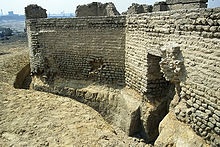Al Fustat
Al Fustat or al-Fustāt ( Arabic الفسطاط, DMG al-Fusṭāṭ 'the tent'), Egyptian-Arabic Fostat , was a city on the Nile in Egypt , which was the administrative center of the country from its foundation in 643 to the foundation of Cairo in 969 . The ruins of Al Fustat can now be visited in the south of Cairo.
history
Al-Fustāt was one of the first cities, along with Basra and Kufa , that the Arabs founded after their conquest of the Middle East . The founder of al-Fustāt was the Arab general ʿAmr ibn al-ʿĀs . He penetrated into Egypt with his Arab fighters in 641, captured the Byzantine-Coptic military fortress of Babylon south of today's city of Cairo and moved from there to Alexandria . After conquering this city, he returned to Babylon in the spring of 643 and founded the new Arab military settlement al-Fustāt next to the old fortress .
The name al-Fustāt is probably the Arabicized form of the Greek word Φοσσάτον (Fossãton, Latin fossatum), which in contemporary bilingual papyri has the meaning of "camp" - based on a garrison town secured to the outside with trenches (Latin fossati ). In the Arabic literary sources, however, the name is explained by the fact that ʿAmr founded the settlement exactly where he had set up his tent (fusṭāṭ) in 641 . As a pigeon sat on his tent that morning when he was about to leave for Alexandria, he left the tent out of respect for the animal. On the triumphant return from Alexandria, the new military settlement was then founded where the tent was still standing.
Until its decline in the 12th century, Fustat was the capital and most important economic center of Egypt. The district of Cairo in which the ruins of Fustāt are located is now called "the old Misr " (Misr al-ʿAtīqa) . This is due to the fact that the city before Cairo in Egypt was the capital city.
The ruins of Fustat have been a UNESCO World Heritage Site since 1979 as part of "historic Cairo" . The mosque of ʿAmr ibn al-ʿĀs has been preserved, but no longer in its original state. According to local reports, the tomb of his son, ʿAbd Allaah, is located in this mosque.
Fustat textiles
Fustāt textiles are cotton fabrics that were found during excavations in Egypt, including in Fustāt. See also: Indo-Egyptian cotton industry .
literature
- Władysław Kubiak: Al-Fustat: its foundation and early urban development. Cairo, American University in Cairo Press, 1987.
- Jacques Jomier: Article “al-Fusṭāṭ” in The Encyclopaedia of Islam. New Edition . Vol. 2, pp. 957b-959a.
Web links
- Hans Barnard: Fustat. barnard.nl
Individual evidence
- ↑ Gundolf Keil : The German Isaak-Judäus-Reception from the 13th to the 15th Century (= European Science Relations . Supplement 2). Shaker, Aachen 2015, ISBN 978-3-8440-3933-7 , pp. 22-25.
- ↑ See Sylvie Denoix: Founded Cities of the Arab World From the Seventh to the Eleventh Centuries , in Salma K. Jayyusi (ed.): The City in the Islamic World Vol. I. Brill, Leiden 2008. pp. 115–142 , here p. 124.
- ^ Historic Cairo. whc.unesco.org, accessed April 26, 2015 (ID 89-001: Al-Fustat ).
Coordinates: 30 ° 0 ' N , 31 ° 14' E
